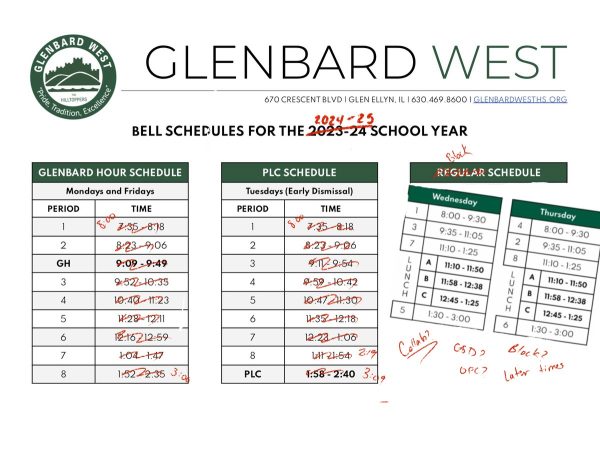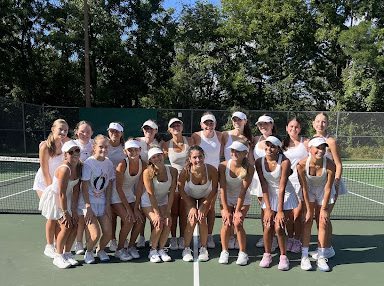Teachers use new and innovative ways to get their students engaged
Hybrid and remote learning create myriad challenges for teaching and learning
“Nervous” and “Excited”— two words that have described the emotions of the Glenbard West community regarding the changes that have been made to e-learning for the first semester of the 2020-2021 school year.
Regarding the decision to be fully-remote for the first couple months of school, “I think it was a very smart decision to keep everyone safe. If we had not done it, it would have been very dangerous for students, teachers, and staff,” says Amina Malik, a current West senior.
Hamza Syed, a current junior, comments, “Obviously it was a bummer to not be able to not see my peers in class again since school ended last year, but I think that it’s important to put safety first. As long as we’re all able to learn in a safe way, I think that the school made the best decision possible for our current situation.”
Remote learning has been a way for schools to ensure the safety of students. So what exactly does learning safely look like? Teachers have been using different applications in order to create an environment similar to that of one in school. Even though it has been difficult, there have been some advantages that teachers have been making the most of.
AP European History teacher Mr. Sanders mentions, “a lot of people have been using Zoom breakout groups and Google Slides to see in real time what people are doing. So things like that have been really, really helpful […] I can see who is participating and who isn’t.”
English Department Head Mr. Peterselli, explains, “Individual breakout rooms allow you to have a lot more one-on-one time with students than you could have in the classroom. You can go and pop in and see a student and they can ask their questions and they can share their screen. I think one of the improved results is that you can connect one-on-one better.”
One of the biggest challenges seems to be maintaining connections with each other. How do students use their digital connections to maintain human connections with each other?
“We do a lot of polls. ‘How are you feeling right now?’ […] ‘Do you understand what I just told you? Let me know.’ And then I’ll throw up a poll and they’ll say: ‘I get it, I sorta get it, you need to explain it to me again, or I don’t even know what you’re talking about.’ Otherwise you could just see those things,” Mr. Peterselli explains. “So one of the big switches is how can we read a student when we can’t see them anymore?”
Mrs. Rosenthal, an AP Biology teacher at West, describes, “Head nods and smiles mean I have successfully explained a tough topic, but staring downward or frowns mean I have work to do. I don’t get this feedback when teaching remote, so I rely on short formative activities for feedback.” She goes on to say, “Nothing will ever be as good as in person teaching and thank goodness because I fear otherwise robots will take my job! Okay, maybe not robots, but humans are social animals and we do better when we’re in proximity to one another.”
Let’s say that schools were to re-open. On October 5th, after carefully assessing the four criteria: health data, staffing, safety protocols and equipment, and quarantine restrictions, it was announced that the District 87 Glenbard High Schools would be transitioning into the hybrid model for those that chose it.
“I think the precautions that we’re taking is the safest that it can be given all the circumstances.[…] Obviously I am still a bit nervous, I think everyone is to some degree about actually coming back even with masks and social distancing and near empty hallways,” Mr. Sanders explains.
“I’m a little nervous. In cold weather COVID cases are likely to increase and if people are at school, that’s not safe. However, I trust the school administration to make the right decision if this does happen,” Amina adds.
With this new transition comes the possibility of going back to regular, in-person learning. However, since the opportunity to explore the option of solely using technology for students’ education has presented itself, how can this experience be used to shape future classroom experiences?
“I’m certainly open to trying to find ways to be available to students as much as I can. […] If we found something that has worked in these past couple months, we’re going to keep doing it. It’s sort of fun to see how innovative some classes have been with all of these new obstacles they have to handle. And quite frankly,” Mr. Sanders continues, “Innovation is the result of necessity.”
Mr. Peterselli notes, “I think it’ll improve the communication between teachers and students outside of the classroom. And I think it also might help us with absent students. […] Why would I sit there and email you back and forth when you and I can hop on a zoom, right? Why would we do that? And I also think what one of the things that it is going to be possible perhaps is that if you’re home sick, you can still somehow connect with the class in real-time, rather than having to: ‘Well, I guess I’ll just wait till tomorrow to see what we did’ right? There’s more potential there too.”
Despite the challenges this pandemic has brought us, there has been some good that has come out of this experience.
“Even though I wanted to be in school in person,” says Hamza, “At least I get more time to sleep. I can also get up and get a snack whenever I want.”
“I’ve been really, really impressed with what all of my students have done, and for what I’ve been hearing other teachers say what their kids are doing. It seems like everyone sort of understands that this is a new and a difficult and uncertain time.” Mr. Sanders ends by saying, “The students here really have phenomenal academic potential. They really are just some great people that I feel lucky to spend some time with. And I would encourage them to keep pushing the envelope.”








